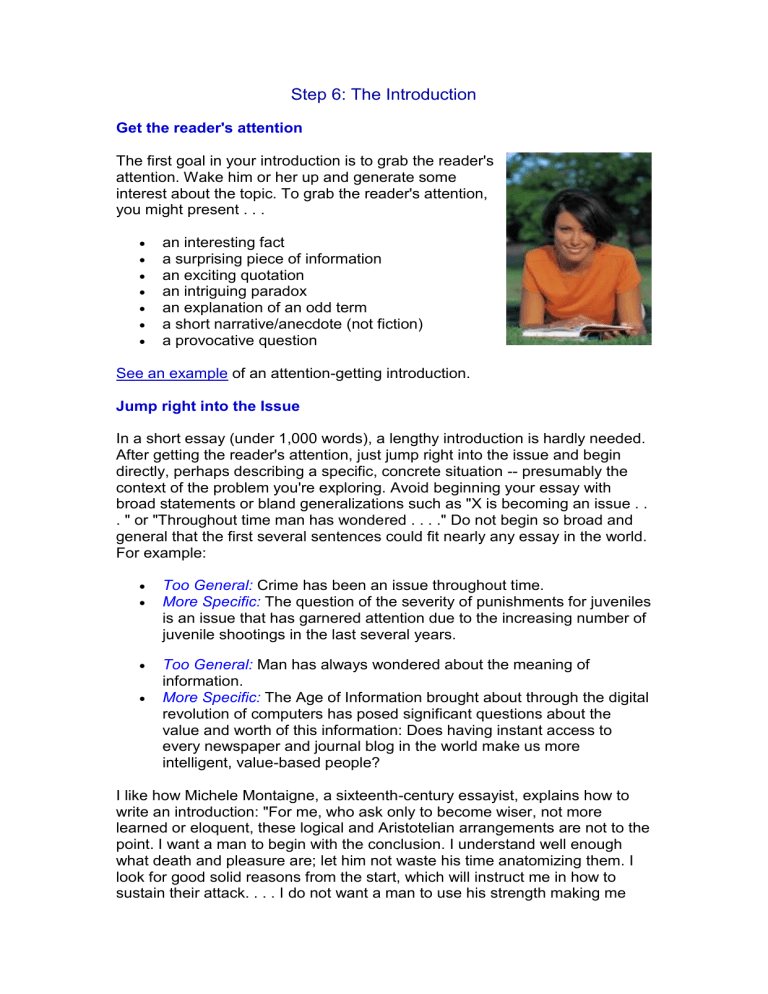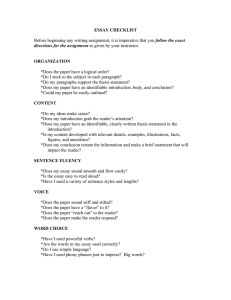step6

Step 6: The Introduction
Get the reader's attention
The first goal in your introduction is to grab the reader's attention. Wake him or her up and generate some interest about the topic. To grab the reader's attention, you might present . . .
an interesting fact
a surprising piece of information
an exciting quotation
an intriguing paradox
an explanation of an odd term
a short narrative/anecdote (not fiction)
a provocative question
See an example of an attention-getting introduction.
Jump right into the Issue
In a short essay (under 1,000 words), a lengthy introduction is hardly needed.
After getting the reader's attention, just jump right into the issue and begin directly, perhaps describing a specific, concrete situation -- presumably the context of the problem you're exploring. Avoid beginning your essay with broad statements or bland generalizations such as "X is becoming an issue . .
. " or "Throughout time man has wondered . . . ." Do not begin so broad and general that the first several sentences could fit nearly any essay in the world.
For example:
Too General: Crime has been an issue throughout time.
More Specific: The question of the severity of punishments for juveniles is an issue that has garnered attention due to the increasing number of juvenile shootings in the last several years.
Too General: Man has always wondered about the meaning of information.
More Specific: The Age of Information brought about through the digital revolution of computers has posed significant questions about the value and worth of this information: Does having instant access to every newspaper and journal blog in the world make us more intelligent, value-based people?
I like how Michele Montaigne, a sixteenth-century essayist, explains how to write an introduction: "For me, who ask only to become wiser, not more learned or eloquent, these logical and Aristotelian arrangements are not to the point. I want a man to begin with the conclusion. I understand well enough what death and pleasure are; let him not waste his time anatomizing them. I look for good solid reasons from the start, which will instruct me in how to sustain their attack. . . . I do not want a man to use his strength making me
attentive and to shout at me fifty times "Or oyez!" in the manner of our heralds. . . . These are so many words lost on me. I come fully prepared from my house; I need no allurement or sauce; I can perfectly well eat my meat quite raw; and instead of whetting my appetite by these preparations and preliminaries, they pall and weary it" ("Of Books").
In other words, don't tire your reader with long introductions that fail to get quickly to the point and issue. Begin with specifics and jump right into the problem or conflict you are addressing. When readers see a good conflict, they are likely to take an interest in it.
Present your thesis
The entire introduction should lead toward the presentation of your arguable assertion, or thesis, whereby you take a stand on the issue you are discussing. Deliver your thesis at the end of the introduction so that your reader knows what general position you will take in your essay. You don't need to spell out all the nitty gritty details of your thesis in the introduction, particularly if it would be bulky and unintelligible to the reader who lacks all the ensuing reference and context, but you should give the reader a good idea of what your argument is. As you do this, avoid saying "I will discuss . . ." or "I intend to argue . . ."
